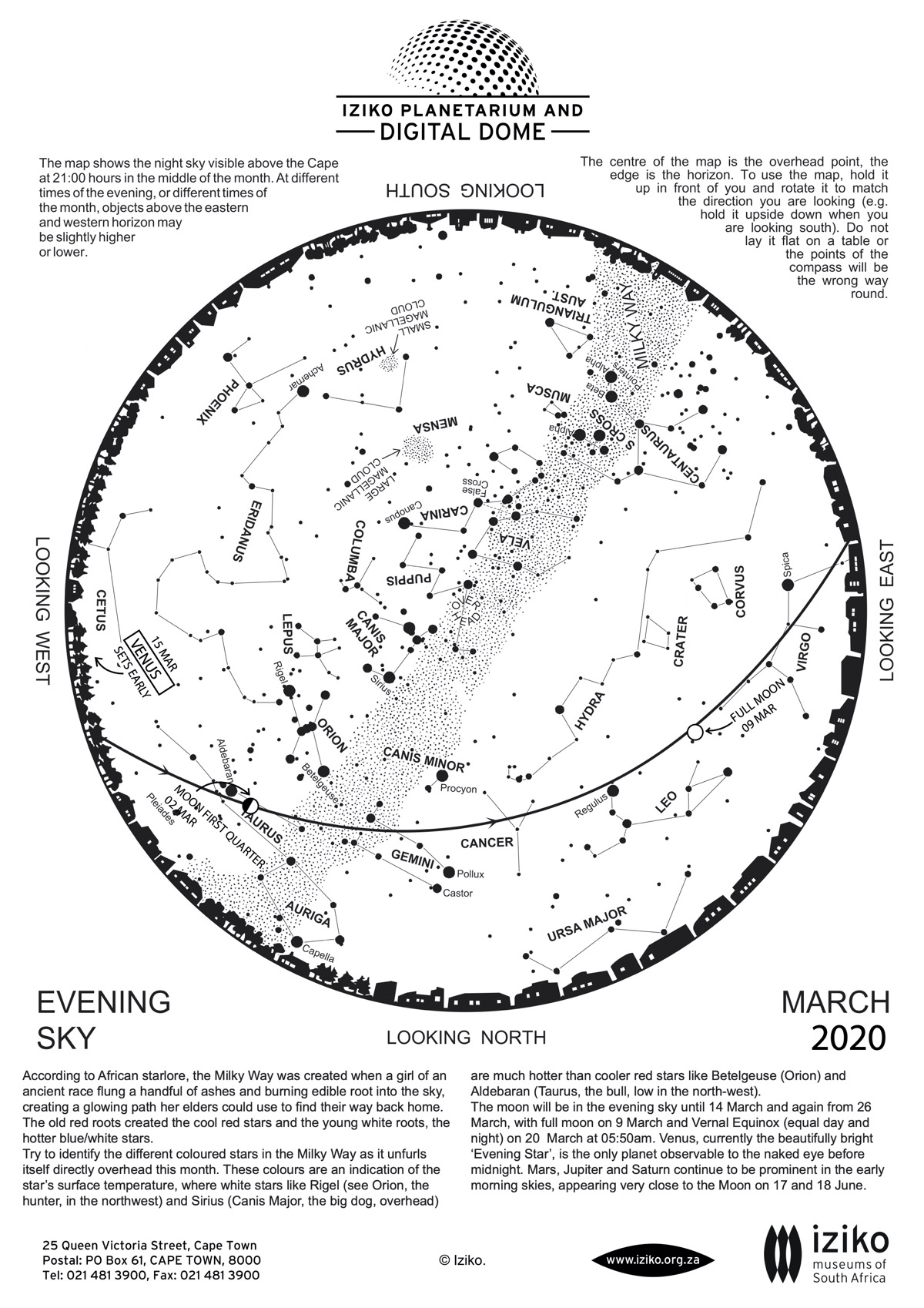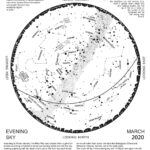
07 Sep Whats Up – September 2020
In a nutshell…
Moon
| Date | Time | Phase |
|---|---|---|
| 02/09 | 07h22 | Full Moon |
| 10/09 | 11h26 | Last Quarter |
| 17/09 | 13h00 | New Moon |
| 24/09 | 03h35 | First Quarter |
Moon – Earth Relations
Perigee: 359 100 km on the 18/09 at 15h44
Apogee: 405 600 km on the 06/09 at 08h31
Sun – Earth Relations
The equinox occurs on the 22nd of September at 15h31.
Planet Visibility
Jupiter and Saturn in Sagittarius visible in the evening sky and at dawn
Mars near Pisces visible at dawn
Venus near Gemini, Cancer and later near Leo at dawn
Mercury near Virgo visible in the evening in the west
Some easy to identify bright stars
Antares: red supergiant in Scorpius
Arcturus: red giant in Boötes
Spica: brightest bluish-white star in Virgo
Canopus: yellowish-white star in Carina
Altair: a white star, brightest in Aquila
Regulus: blue–white star and the brightest star in Leo
The Pointers: Alpha and Beta Centauri
Sun and Moon
The Full Moon occurs on the 2nd of September at 07h22 and the Last Quarter Moon falls on the 10th of September at 11h26. The New Moon occurs on the 17th of September at 13h00 and the First Quarter Moon falls on the 24th of September at 03h35.
The moon’s orbit around the Earth is slightly elliptical, with the distance between the two bodies varying somewhat over the course of a month. On the 6th of September at about 08h31 the Moon will be at apogee (furthest from Earth) at a distance of about 405 600km. On the 18th of September at about 15h44 the Moon will be at perigee (closest approach to Earth) at a distance of about 359 100km.
The (southern hemisphere) spring equinox is predicted to occur on the 22rd of September at 15h31. At this time the Sun will be located directly above the earth’s equator, as it appears to move southwards. This is the second instance of this occurring during the year, the other instance being of course the autumn equinox, which occurs about 6 months earlier when the Sun is on its northbound journey. The spring equinox marks the promise of warmer days ahead for those in the southern hemisphere, while for those in the northern hemisphere colder days lie in wait. These seasonal changes are the result of the tilt of Earth’s rotation axis relative to is orbit around the Sun.
Planetary and Other Events – Morning and Evening
The biggest planet in our solar system, Jupiter is dazzling the night sky and is located near the stars of the constellation, Sagittarius. Jupiter, Saturn and the dwarf planet Pluto will be near the Moon on the 25th of September. Saturn is also visible in the night sky and can be located near the stars of the constellation, Sagittarius. Mercury, the smallest planet in our solar system can also be seen just after sunset near the stars of the constellation Virgo and can be seen in the Western skies. Venus, the hottest planet in our solar system is visible at dawn and is located near the stars of the constellation Gemini at the beginning of the month and is located the stars of Leo by the end of the month. Venus is near the Moon on the 14th of September. Mars, the red planet can be seen near the stars of the constellation, Pisces. The red planet is near the Moon on the 6th of September. Uranus can be observed with an aid of a big telescope near the stars of the constellation Cetus and is near the Moon on the 7th of September. Neptune can be located near the stars of the constellation Aquarius. Neptune reaches opposition and is well placed for observation from the 11th of September.
The Evening Sky Stars
The winter Milky Way still sweeps majestically across the sky from NNE to SSW in early September evenings, and the centre of our Milky Way galaxy is almost overhead. Just to the west of the zenith is the Scorpion, with the reddish star Antares at its heart. Antares (or ‘rival of Mars’) is a huge star 600 light years away, shining in visible light with 12000 times the power output of our own sun. But Antares is also so much cooler than the sun (hence the red colour) that most of its energy output is in the infrared, and its total power output is 40000 times that of the sun. If Antares were suddenly placed at the centre of our solar system, Mercury, Venus, the Earth, Mars and the asteroid belt would be inside this monster star, whose vaguely defined surface would lie 4/5 of the way from the star’s centre to the orbit of Jupiter. Gravity at the surface of Antares is so weak that it is losing mass fast enough to create a visible nebula or gas cloud around it, lit by Antares hot companion star. In the next few million years or so, Antares may explode as a supernova — so keep your eyes on the Scorpion if you’re the patient sort. Just NE of Scorpio in the Milky Way are the stars of Sagittarius the Archer, making a pattern a bit like a teapot. It’s in this constellation that the centre of our galaxy is located, but you can’t actually see the centre directly because of the thick dust clouds in between. Only one in a billion photons of visible light from the Galactic Centre can get through, and infrared cameras are needed to show what’s there. Infrared observations of stars orbiting the centre suggest that right at the centre is a black hole about 3 million times as massive as our sun.
High in the NE, toward the edge of the Milky Way, is the bright star Altair in Aquila the Eagle. Altair is easy to recognize because of the dimmer stars more or less equally spaced on each side. Another bird constellation, low in the NE and thoroughly tangled in the Milky Way, is Cygnus the Swan, also known as the Northern Cross. At the NE end (top) of the Cross is Deneb, the tail of the Swan. Deneb is much more distant than most of the stars we see with the unaided eye, and its true brightness has been estimated at 160 000 suns. To the right (W) of Deneb is another bright northern star, Vega, only about 1/100 as far away at only 25 light years. Vega is really much dimmer than Deneb, but appears brighter because it is so much closer. If Deneb were as close as Vega, it would be by far the brightest star in the sky, as bright as a thickish crescent moon!
Low in the NW in early evening is the bright star Arcturus, with Spica glowing low in the west amidst the ‘dance of the three planets’ described above. Higher in the west (and just north of the Scorpion) is the curious constellation of Ophiuchus the Serpent Holder. One half of the Serpent stretches from the hands of Ophiuchus toward Arcturus and the Northern Crown in the NW, while the other extends along the Milky Way toward the Eagle. South of the Scorpion are the Altar, the Level and the Wolf, while further south we find the Centaur (including the Pointers) and the Southern Cross. Fomalhaut is now high in the east, with bright Achernar low in the southeast, ninth brightest star in the sky.
The Morning Sky Stars
By the time the Earth’s rotation allows us to see the predawn September sky, Achernar (the ‘mouth’ of the celestial river Eridanus) is much higher in the south, with Fomalhaut (in the Southern Fish) low in the SW. Achernar is spinning so fast that its equatorial diameter is about 11.8 times that of the sun, while its polar diameter is only 7.6 times solar. Partly due to its very fast spin, Achernar is losing mass thousands of times as fast as our own sun, and is thousands of times as bright. According to ancient South African starlore, if the Senakane (the little horn) (Achernar) rises in the East very bright and giving off little lightnings, and the bullrushes are still in flower, men fear an early frost. The shield of the little horn is the Small Magellanic Cloud, known as mo’hora le tlala, ‘plenty and famine’. If dry dusty air made it appear dim, famine was to be expected.
High in the southeastern sky is Canopus, second brightest star in our skies and the brightest star in the ancient constellation of Argo, the great ship. High in the east is Sirius, brightest star in the sky as seen from Earth. If Canopus were at the same distance as Sirius, however, it would shine about 400 times brighter. Sirius is the brightest star in Orion’s Large Dog, and the stars of Orion, including bright Rigel and Betelgeuse, are high in the NE before dawn this month. Charging Orion is Taurus the Bull, with Aldebaran serving as an inflamed orange eye. No wonder Orion has his hide shield raised in front of him. Behind Orion, his Small Dog (with the bright star Procyon) is prudently staying on the safer side of the contest, while totally indifferent to all this drama, Auriga the Charioteer (with the bright star Capella) drives by low in the north.
Sivuyile Manxoyi
Sivuyile@saao.ac.za
The evening sky over Cape Town
The evening sky over Johannesburg


